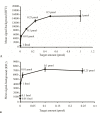Effect of Target Length on Specificity and Sensitivity of Oligonucleotide Microarrays: A Comparison between Dendrimer and Modified PCR based Labelling Methods
- PMID: 24551024
- PMCID: PMC3927376
- DOI: 10.2174/1874091X01408010011
Effect of Target Length on Specificity and Sensitivity of Oligonucleotide Microarrays: A Comparison between Dendrimer and Modified PCR based Labelling Methods
Abstract
DNA microarrays are widely used as end point detectors for gene expression analysis. Several methods have been developed for target labelling to enable quantification but without taking target length into consideration. Here we highlight the importance of choosing the optimum target length that would ensure specificity without compromising sensitivity of the assay. For this, eight plasmids that are identical to each other except for a closely related 23 bp unique reporter (UR) sequence were used to examine the hybridization efficiency for these URs. Targets of various lengths were generated and labelled as follows: full length and 330 bases transcripts using a dendrimer labelling method, 120 bp amplicons by the modified PCR end labelling method and synthetic labelled targets of 33 bases. This report also shows the advantages of using the modified PCR method over other labelling methods in generating labelled amplicons of the desired lengths to maximize hybridization efficiency.
Keywords: Dendrimer.; Hybridization specificity; Oligonucleotide microarrays; PCR; Secondary structure; Sensitivity.
Figures





Similar articles
-
Effects of target length on the hybridization efficiency and specificity of rRNA-based oligonucleotide microarrays.Appl Environ Microbiol. 2007 Jan;73(1):73-82. doi: 10.1128/AEM.01468-06. Epub 2006 Oct 27. Appl Environ Microbiol. 2007. PMID: 17071797 Free PMC article.
-
Evaluation of amplified cRNA targets for oligonucleotide microarrays.Anal Bioanal Chem. 2007 Apr;387(8):2645-54. doi: 10.1007/s00216-007-1125-2. Epub 2007 Feb 7. Anal Bioanal Chem. 2007. PMID: 17285305
-
Investigating the sensitivity of a fluorescence-based microarray for the detection of fruit-tree viruses.J Virol Methods. 2008 Mar;148(1-2):96-105. doi: 10.1016/j.jviromet.2007.10.018. J Virol Methods. 2008. PMID: 18079006
-
[Quantitative PCR in the diagnosis of Leishmania].Parassitologia. 2004 Jun;46(1-2):163-7. Parassitologia. 2004. PMID: 15305709 Review. Italian.
-
Experiences on the application of the polymerase chain reaction in a diagnostic laboratory.Mol Cell Probes. 1993 Jun;7(3):241-8. doi: 10.1006/mcpr.1993.1035. Mol Cell Probes. 1993. PMID: 8366870 Review.
References
-
- Pollack JR, Perou CM, Alizadeh AA, Eisen MB, Pergamenschikov A, Williams CF, Jeffrey SS, Botstein D, Brown PO. Genomewide analysis of DNA copy-number changes using cDNA microarrays. Nat. Genet. 1999;23:41–46. - PubMed
-
- DeRisi JL, Iyer VR, Brown BO. Exploring the metabolic and genetic control of gene expression on a genomic scale. Science. 1997;278:680–686. - PubMed
-
- Drmanac S, Kita D, Labat I, Hauser B, Schmidt C, Burczak JD, Drmanac R. Accurate sequencing by hybridization for DNA diagnostics and individual genomics. Nat. Biotechnol. 1998;16(1):54–58. - PubMed
LinkOut - more resources
Full Text Sources
Other Literature Sources
